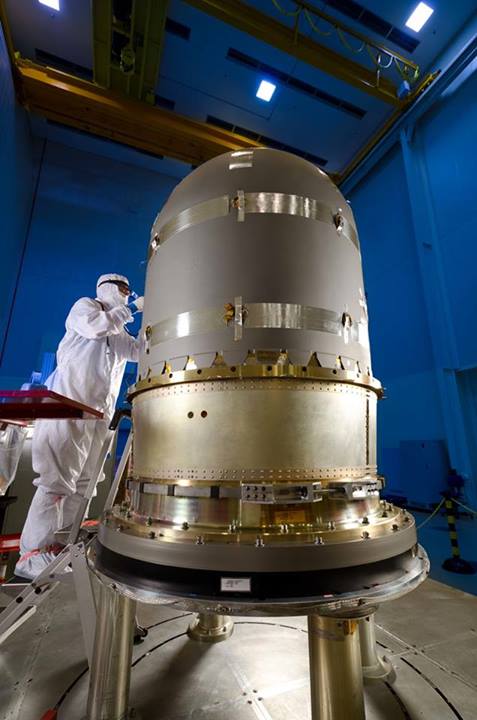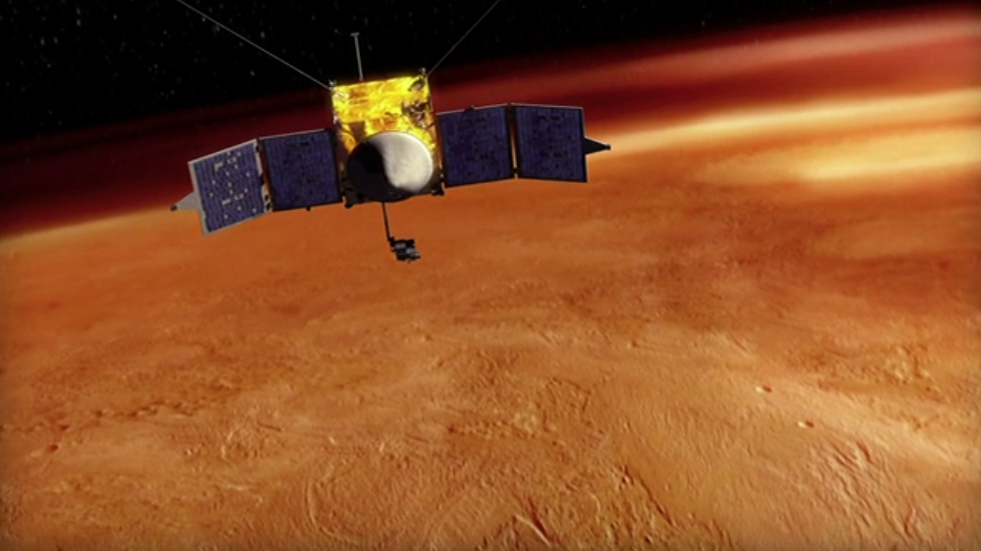
NASA’s next spacecraft destined for Mars, MAVEN, is in its final few weeks of pre-launch processing at Kennedy Space Center in Florida, and this past week team members from Lockheed Martin performed some final tests before fueling the spacecraft for its $670 million mission to the Red Planet.
On Tuesday, Oct. 22, engineers and technicians performed a dry spin test on the spacecraft inside KSC’s Payload Hazardous Servicing Facility, rotating MAVEN up to 10 times per minute in order to verify that the spacecraft is properly balanced as it spins during initial mission activities. At the same time the protective payload fairing which will encapsulate MAVEN for its Atlas-V rocket launch vehicle was moved into the Payload Hazardous Servicing Facility’s high bay.

A few days later, on Friday, Oct. 25, the spacecraft was fueled with 431 gallons of highly toxic hydrazine, which MAVEN will use as a propellant for control and trajectory adjustments during its 10-month journey, or “cruise phase,” to the Red Planet. MAVEN will only actually need very little of this fuel for the cruise phase itself, as thrusters on the spacecraft’s cruise phase will only fire to adjust MAVEN’s flight path during the cruise phase and approach phase. Most of the fuel will be conserved for MAVEN’s arrival at Mars in September 2014, when it will need most of that 431 gallons to place itself into position for orbit insertion and performing orbital correction maneuvers once at Mars. The fuel will also help MAVEN maintain a correct elliptical orbit throughout the mission and will boost the satellite into a higher elliptical orbit at the end of its mission to relay data from other spacecraft (including the Curiosity and Opportunity rovers) currently exploring the surface of the Red Planet.
Next on the team’s agenda is encapsulation of the 5,400-pound, fully fueled MAVEN spacecraft into the payload fairing for its 200-foot-tall Atlas-V rocket launch vehicle, which is tentatively planned for Nov. 4. MAVEN will then begin the slow move, or rollout, from Kennedy’s Payload Hazardous Servicing Facility to Space Launch Complex-41 (SLC-41) at nearby Cape Canaveral Air Force Station on Nov. 6.

The United Launch Alliance (ULA) Atlas-V rocket, which will send MAVEN on its way, is already waiting at SLC-41, standing vertical and awaiting MAVEN’s arrival. The rocket’s first stage booster was hoisted vertical inside SCL-41’s Vertical Integration Facility, or VIF, on Oct. 11, and the rocket’s upper stage Centaur was hoisted atop the core booster a few days later on Oct. 14. ULA has already powered on the stacked launch vehicle with no problems occurring, and a Combined Systems Test, which is an electrical test of the rocket, was conducted on Oct. 22.
MAVEN has been undergoing a rigorous schedule of final testing in the Payload Hazardous Servicing Facility at KSC since the spacecraft arrived in Florida on Aug. 2. Thorough tests of software and hardware systems, inspection and cleaning of the solar panels, verification tests of the various spacecraft subsystems and payloads, and readiness reviews have all been completed. With work on the spacecraft itself nearly complete, and after a decade of work from people across the country, attention now turns toward launch, which is less than one month away.
NEXT STOP, MARS
“We have a three-week launch window that starts on Nov. 18. If we miss that window we have to wait another 26 months, so you can imagine the team is working really hard to be ready,” said Bruce Jakosky, principal investigator for MAVEN at the Laboratory for Atmospheric and Space Physics at the University of Colorado Boulder. “Hopefully we will launch during the first minute of the first day.”
MAVEN’s three-week launch window of opportunity opens at 1:28 p.m. EST Nov. 18, with a two-hour launch window available on each day during those three weeks. Once launched, MAVEN will take 10 months to push through the emptiness between our worlds, arriving at Mars on Sept. 22, 2014. It will take five weeks for the spacecraft to get into its final science-mapping orbit, test the instruments, and test science mapping sequences. MAVEN will then be ready to begin its one-Earth-year primary mission.
MAVEN will help answer questions about how, when, and why the Red Planet’s atmosphere has nearly disappeared, leaving the planet a dead, dry, desolate landscape. MAVEN, however, will not land on the surface, but will instead position into an elliptical orbit around Mars to—for the first time—thoroughly study the Martian upper atmosphere by measuring the current rate of escape of atmospheric gas to space. Those measurements will provide information about the relevant processes to allow extrapolation backward in time to determine how much of the Martian atmosphere has been lost over the eons.

“A better understanding of the upper atmosphere and the role that escape to space has played is required to plug a major hole in our understanding of Mars,” added Jakosky. “We’re really excited about having the opportunity to address these fundamental science questions. MAVEN is not going to detect life, but it will help us understand the climate history of Mars, which is the history of its habitability.”
At its closest point to the planet, the spacecraft will be 93 miles above the surface, allowing MAVEN to sample the gas and ion composition of the Martian upper atmosphere directly on each orbit. Five “deep dives” are planned to place MAVEN even closer to the surface (77 miles), which will provide information down to the top of the well-mixed lower atmosphere, giving scientists a full profile of the top of the atmosphere. At its highest point MAVEN will be more than 3,728 miles above the surface, allowing for ultraviolet imaging of the entire planet.

“MAVEN is going after something the others haven’t,” said David Mitchell, MAVEN’s project manager for NASA’s Goddard Spaceflight Center in Maryland. “It’s going to look at the current composition of the upper atmosphere and how solar storms and other factors changed the atmosphere. We’ll then be able to project back in time to see how it was in an earlier epoch. Scientists believe the planet has evolved significantly over the past 4.5 billion years. It had a thicker atmosphere and water flowing on the surface. It wasn’t like Earth, but it was not like it is today.”
MAVEN will join three other NASA spacecraft currently orbiting the Red Planet on their own missions (Mars Odyssey, Mars Express, and the Mars Reconnaissance Orbiter). Two other vehicles are currently exploring the surface, the rovers Opportunity and Curiosity. All six spacecraft will work to do their own part in piecing together the puzzle of Mars’ history, helping to answer questions about water, habitability, and—ultimately—whether or not life ever had a chance to thrive before the atmosphere withered away and sterilized the planet.
“There’s something about going to another planet that’s very exciting,” Mitchell said. “When you’re talking about going to Mars, it isn’t hard to get great people to come work the job. And, ultimately, the mysteries that MAVEN will help decipher should be a treasure trove for the science community.”
Want to keep up-to-date with all things space? Be sure to “Like” AmericaSpace on Facebook and follow us on Twitter: @AmericaSpace
Missions » MAVEN »



With the end of the launch-threatening government shutdown, I’m looking forward to a successful launch and the return of some truly fascinating, invaluable information. For awhile there, it seemed as though we were really going to have to wait twenty-six months for the next launch window to open, and of course there would be additional cost. There has GOT to be a better way to secure long-term planning and funding for NASA.
It was a concern at first, but early in the shutdown, NASA established that the launch wouldn’t be delayed. http://newswatch.nationalgeographic.com/2013/10/04/nasa-shutdown-wont-stop-maven-launch/
But yes, they were lucky. If the launch window hadn’t been so soon, I imagine the mission would’ve been halted.